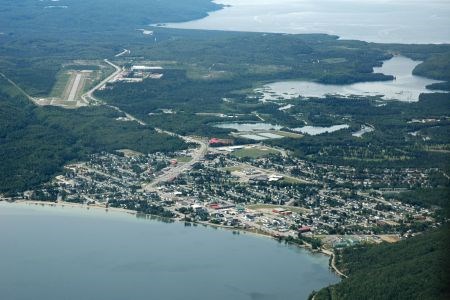Wawa has taken its fair share of hits in the last 15 years.
The 1998 closure of the Algoma Ore Division (AOD) sent this North Shore town's economy tumbling, and it's still searching for recovery.
But there appears to be some signs of hope on the horizon, or at least below it.
Exploration for gold is slowly returning the municipality of 2,900, located between Thunder Bay and Sault Ste. Marie, to its natural resources' roots.
There is a plethora of exploration activities underway and the spinoffs are slowly weaving their way through the local business community.
Maury O'Neill, CEO of the Economic Development Corporation of Wawa, said her department is preparing to do an economic gap analysis to figure out what Wawa must do on the supply and services end to better cater to the mining companies.
“We need to find out what we can do to attract new business and strengthen existing business to carry new products, and how we can take advantage of the growing mining sector.”
The closure of AOD, the town's economic mainstay since the turn of the last century, resulted in the elimination of 220 jobs and about $10 million in lost wages.
Soon after, Weyerhaeuser closed its oriented strandboard mill in November 2007, resulting in 148 people being laid off. The mill is up for sale by the forestry giant, but without an attached Crown wood supply, the likelihood that a new investor will purchase the property is remote, said O'Neill.
“Our community has been in decline since then and we've not recovered.”
With Wawa's major smokestack industries gone, some supporting retail and service suppliers closed up shop. But those businesses that stuck it out through tough times are slowly realizing the benefits.
“We're now seeing the spinoffs in hotels, vehicle sales and aircraft at our airport buying fuel; it filters through the whole community,” said O'Neill.
A local janitorial supply store now stocks items that miners, exploration outfits and prospectors all need such as mining overalls and work boots. A tire store is hiring young people to service the mining industry.
“It'll take some time but maybe we'll see a resurgence back into our service sector,” said O'Neill.
The Wawa gold camp has two producing mines with nearby Wesdome Gold Mines, 50 kilometres to the west, and Richmont Mines, 83 kilometres to the northeast.
Wesdome's Eagle River Mine and Mishi Pit have produced 848,001 ounces of gold between 1995 and 2010. Richmont's Island Gold Mine has produced 160,101 ounces of gold at its Island Gold operation between 2006 and 2010.
Wesdome has been a bulwark of the area's economy since the late 1980s. The Toronto-headquartered miner has steadily upgraded and expanded its operations including building an assay lab at its Wawa field office.
O'Neill said the company always provides an opportunity for students and young people to stay in the community.
Richmont has made a concerted effort to hire locally whenever possible and has been promoting mining careers in Wawa, Dubreuilville and the Michipicoten First Nation by encouraging locals to obtain common core training through its partnership with Northern College.
O'Neill said while the community is grateful to have two working mines, there is the possibility of a third coming into existence.
Prodigy Gold has released a preliminary economic assessment at the former Magino Mine. The company is conducting a 60,000-metre diamond drill program to add ounces onto its 2,176,000-ounce indicated resource.
Other exploration juniors with potential include Augustine Ventures and Strike Minerals that are searching the Wawa gold camp where there have historically been 21 gold mines producing more than 2.6 million ounces.
Wawa has also joined the ranks of a handful of communities showing interest in hosting an underground nuclear waste repository.
After first contacting the Nuclear Waste Management Organization (NWMO) in the spring of 2011, the municipality has progressed into a third stage of exploratory talks.
O'Neill said local reaction from residents has been mixed, ranging from extreme rejection of such a facility, to those who want to know more.
NWMO officials have toured the Wawa area on their pre-feasibility rounds and will research the area's geology.
Though the final site selection is a decade away, O'Neill said Wawa will see short-term benefits from the influx of professionals coming into the community during the exploratory phase.
“There will be a huge amount of benefits for any community that goes through this process.”




